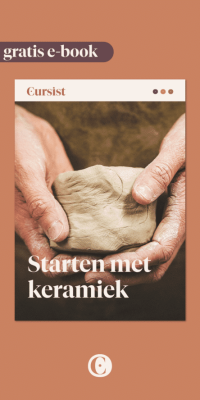Using a new glaze for the first time is very exciting. Will the result look as you expect? To better assess what your workpiece will look like after firing, you can make some test tiles first. But even with that precaution, you’re still not always sure of the results. Because sometimes the glaze on your piece does look very different from the one on the test tile. Why is that?
1 Did you use a different type of clay?
One clay is not like another. The same glaze sometimes gives a completely different result if you use a different type of clay. This is due not only to the color of the clay, but also its composition. So make sure you have a test tile that was made from the same clay as your piece.
2 Did your ingredients have a different composition?
The ingredients in a glaze recipe are raw materials extracted from the earth, such as chalk, quartz, dolomite … And that always brings a bit of variation. The chalk you get in one bag may have a slightly different composition than the chalk from another bag because it comes from a different mine, for example. Did you just open a new bag for the glaze for your piece? Then the result will look different from the test tile.
3 Was the firing schedule different?
By firing the glaze, it melts and reacts with the clay. How the final result looks, depends on two factors: how long it takes for the glaze to melt, and how long it takes for it to then cool again. These factors depend mainly on the kiln you use, and on the firing schedule. But even if you use the same kiln and firing schedule, you may still see variations in the end result, depending on exactly how you fill the kiln. For example, a full kiln cools less quickly than a half-full kiln. Want to get a better understanding of the firing process of your piece? Then you can use cones.


4 Did you weigh the ingredients accurately?
If you make a smaller amount of glaze for a test tile, you often have to deal with very small amounts. For example, your recipe calls for 1.5% cobalt. For a batch of 100 grams, that works out to 1.5 grams. But if your scale only shows 1 or 2 grams, you have to guess for yourself when you put 1.5 grams on the scale. That may seem like just a little difference, but it can have big implications for your end result. Therefore, many ceramists buy scales that can measure more precisely, although that comes with a more expensive price tag. Another option is to make a slightly larger batch right away. For example, if you make a batch of 200 grams, you can easily weigh out 3 grams of cobalt.
5 Did you use more or less water?
If the layer of glaze on your piece is thinner or thicker than the one on your test tile, your result will also look different. This is sometimes due to the shape or thickness of your piece, or sometimes due to the way you applied it – maybe you dipped your piece just a little longer? -, but it may also be due to the ratio of water versus glaze. To make sure you use the same ratio, it’s best to neatly weigh the amount of water you add. That way you can keep the same proportions in the next batch as well.





